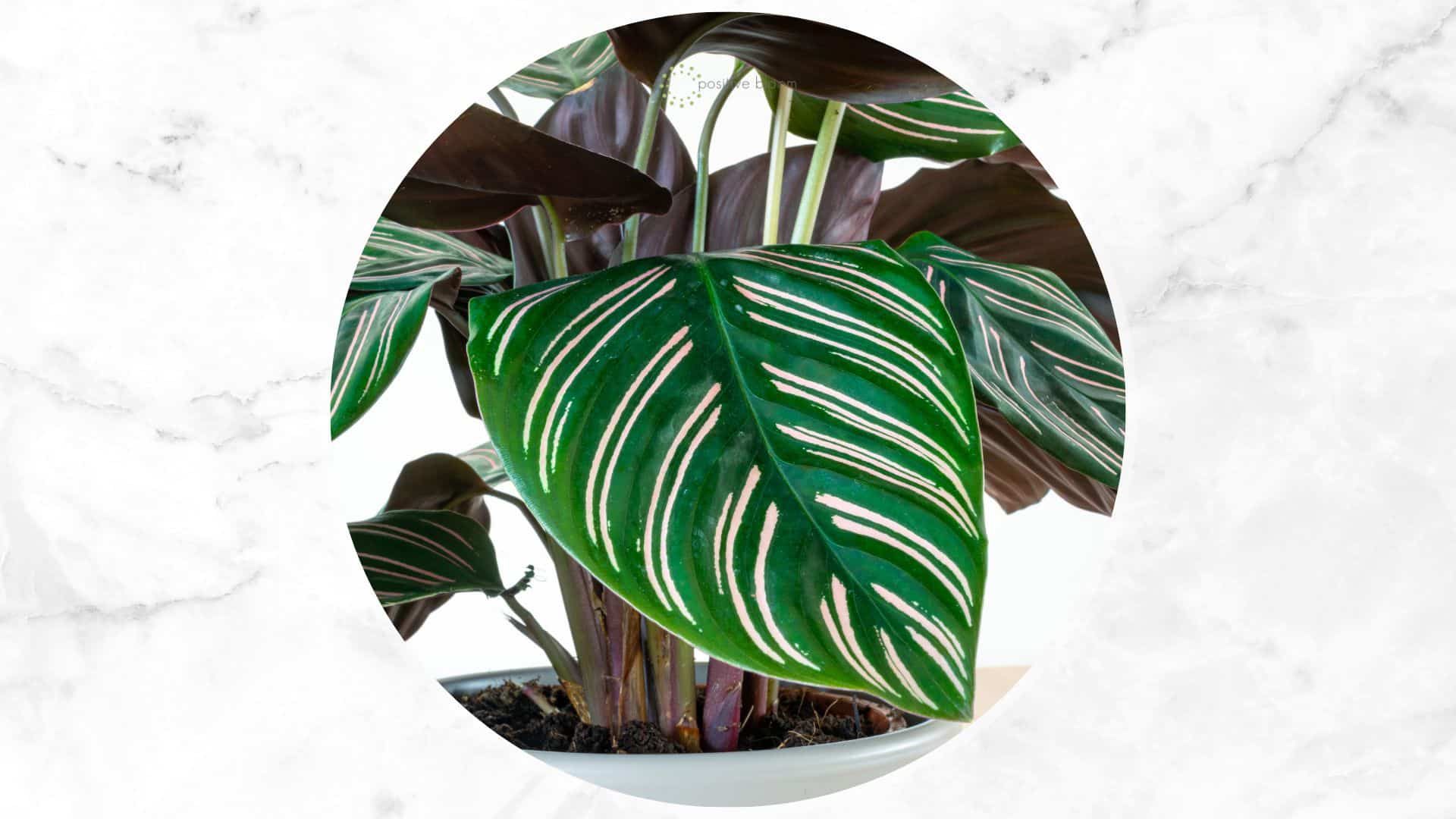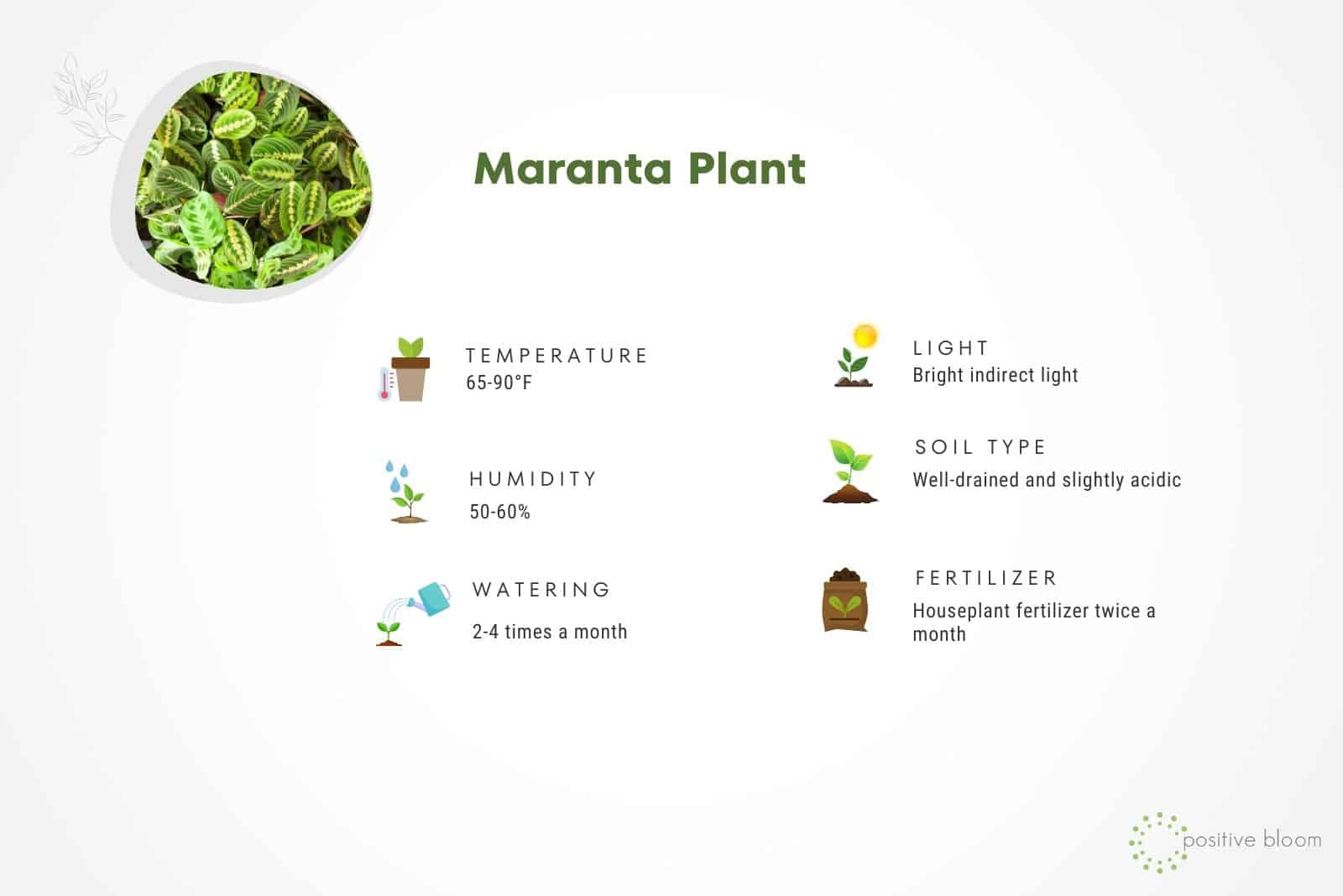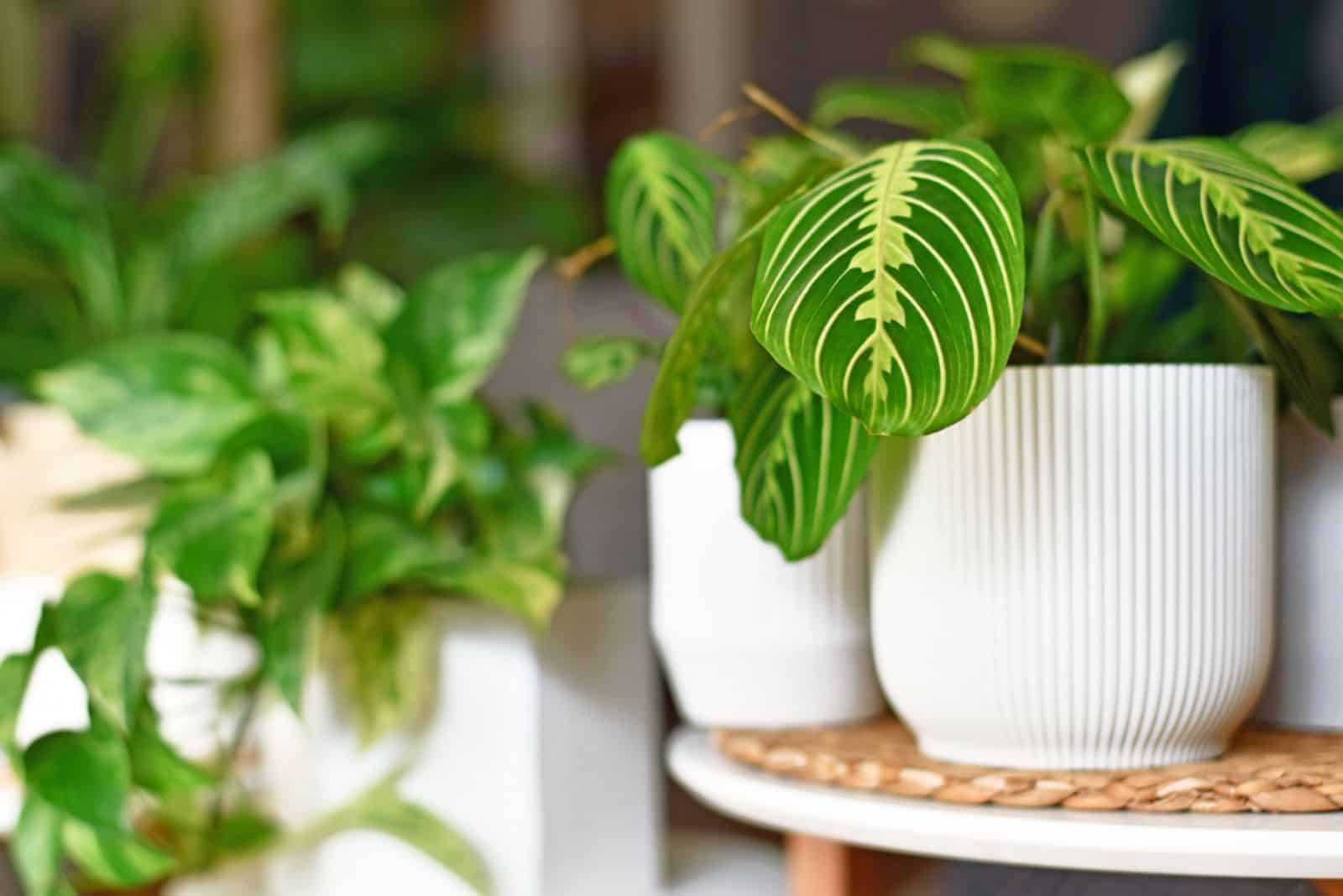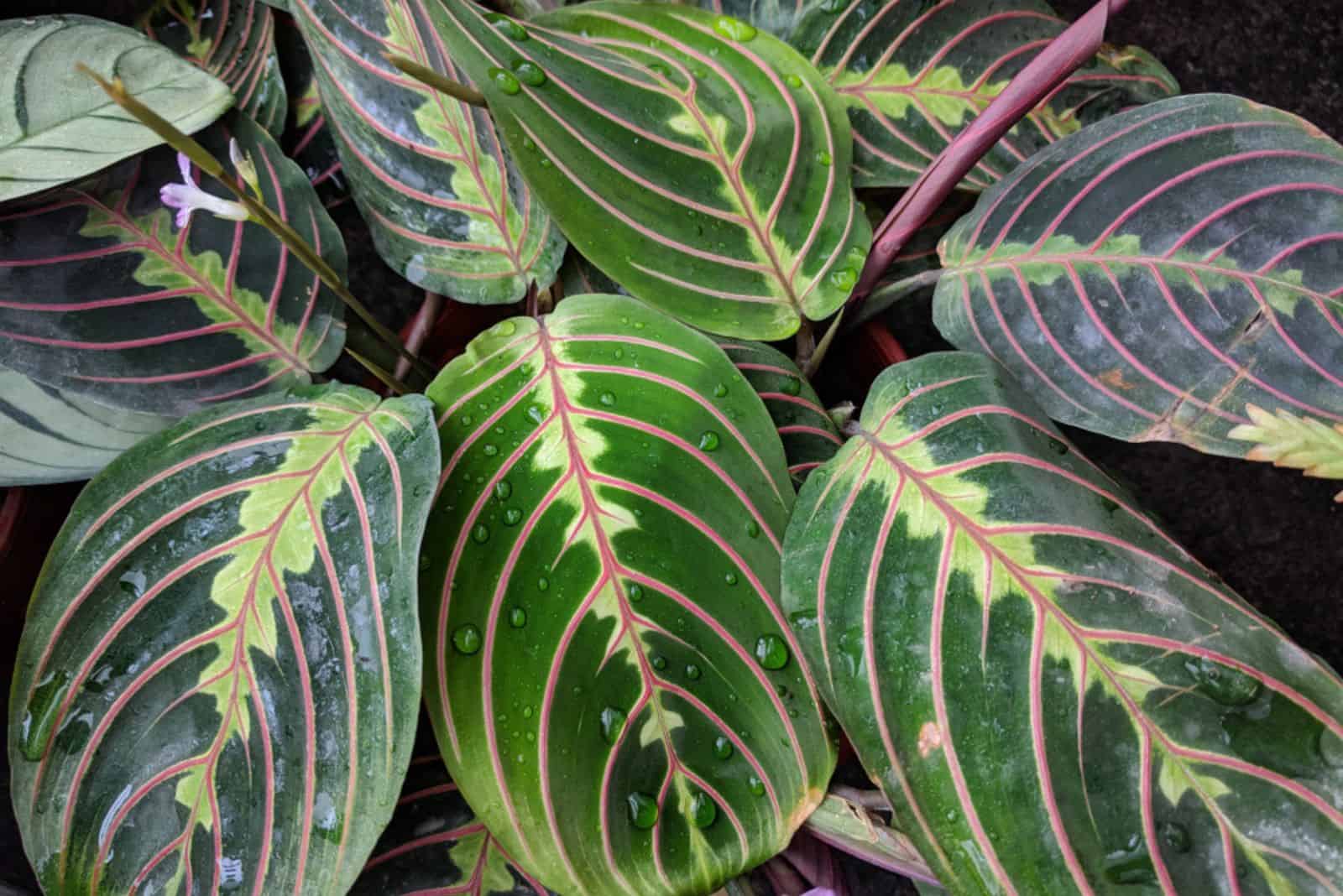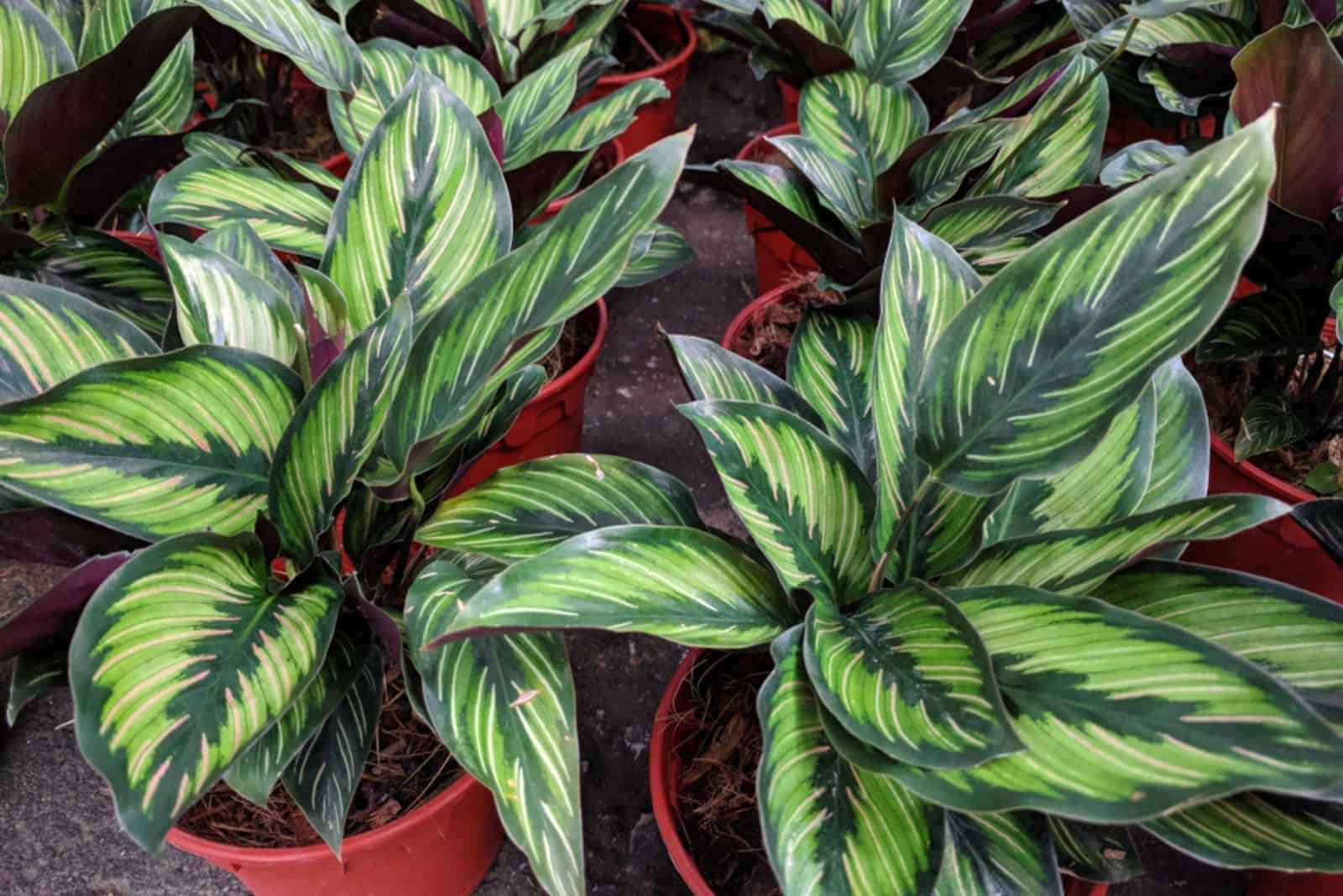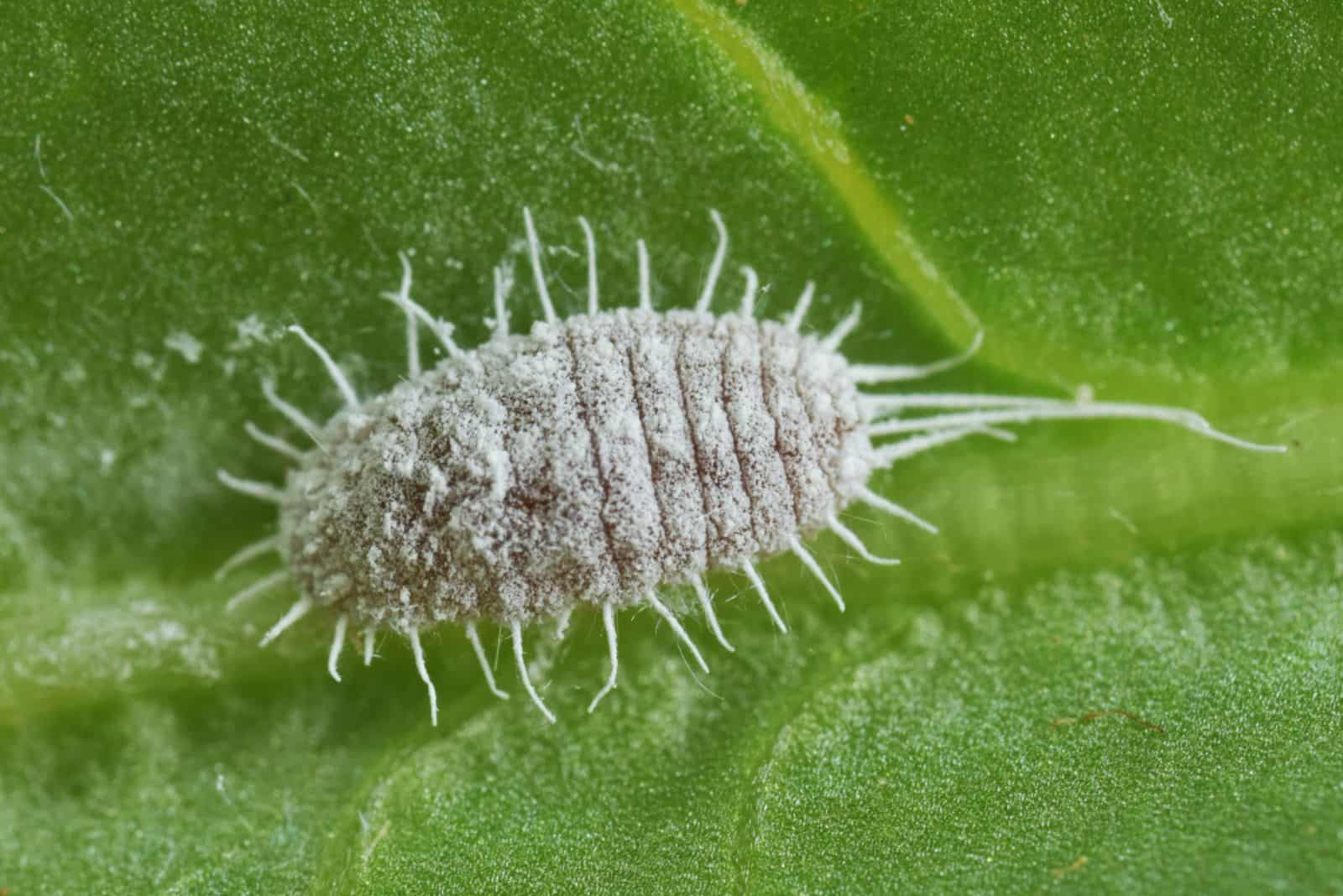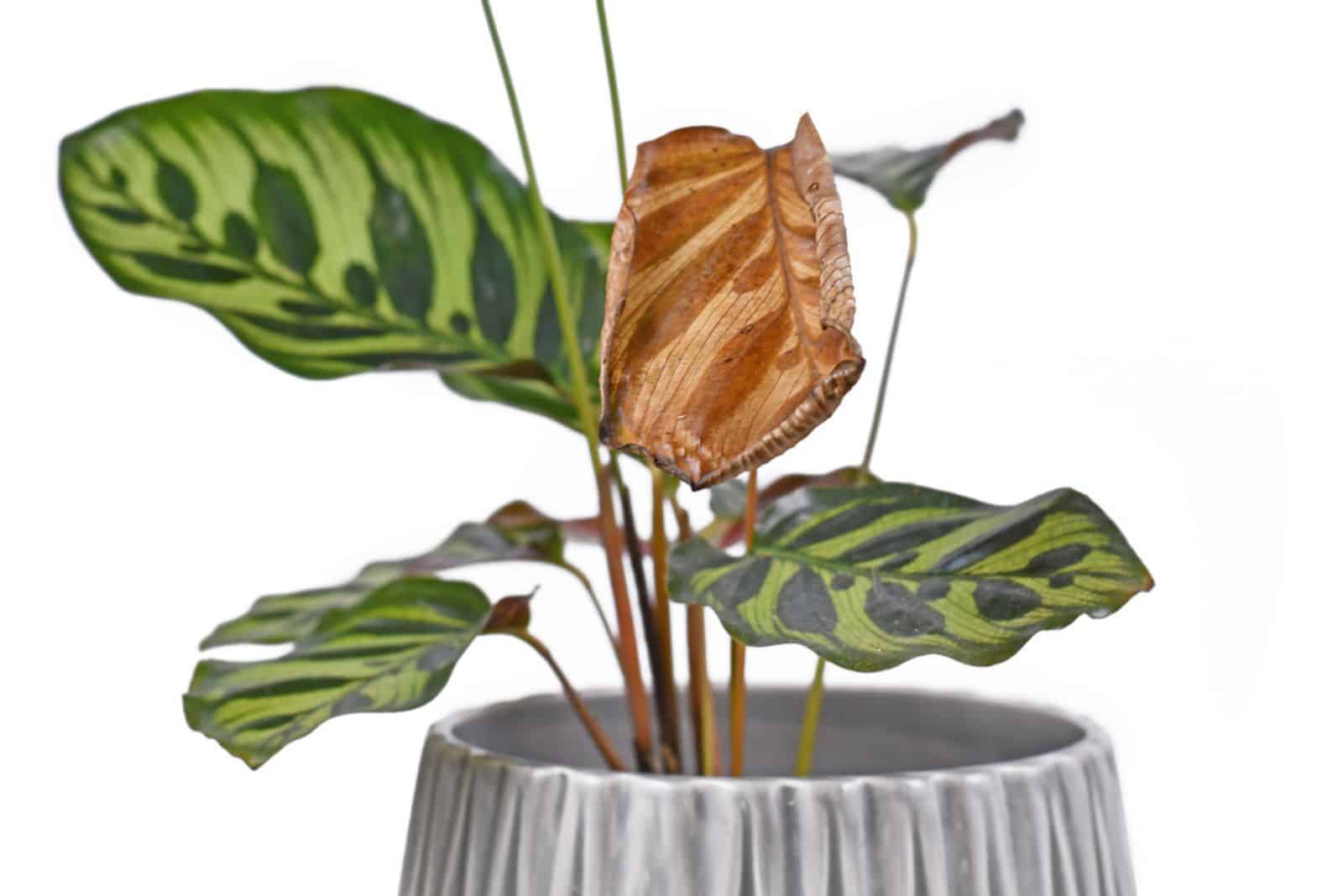Prayer plants are very popular houseplants nowadays, and for some good reasons. First of all, they produce magnificent leaves that have a unique feature of folding themselves during the night – this is how they got the name “prayer plant”.
Second of all, these lovely plants are relatively easy to grow. You won’t even break a sweat taking care of these plants!
Lastly, there are a lot of different prayer plant varieties from which you can pick and choose, and I’m positive that you will find the perfect one for your home!
Plants that are referred to as prayer plants mostly include Maranta plants, though some other plant species, such as Calathea, have also been called this because they share common features.
Keep reading to see how to take care of these unique plants!
What Are Prayer Plants?
Prayer plants are tropical plants that originate from Brazil. These plants are special in that they move throughout the day, then close their leaves at night and open them again in the morning.
The name “prayer plant” comes from the way they appear to be praying when their leaves are closed.
This characteristic is shared by more than 500 plant species, including those in the Marantaceae family and the Calathea, Ctenanthe, and Stromanthe genera. All of these plants can be identified by this particular movement, which is called nyctinasty.
If you want to know more about this peculiar behavior, then check: Prayer Plant At Night: Do These Plants Actually Pray?
Famous Prayer Plant Varieties
Since there are so many of these plants, it can be hard to choose which one to get. Here are our top picks, though I’m sure that you would be happy with any prayer plant variety since they are all absolutely adorable!
• Lemon lime prayer plant – also known as the Lemon lime Maranta, this plant has thick veins and varies in color from bright green to burgundy in their patterns. Both sides of the leaves have lovely patterns, so when they close up, you get to see the best of both sides!
• Calathea white star – it produces oval-shaped, dark green leaves. Condensed white stripes can be seen all over these leaves. It can also produce stunning pink to orange blossoms under the right growing conditions.
• Maranta leuconeura ‘massangeana’ – this variety also produces oval-shaped green leaves, but they have white variegations along the midrib of the veins.
• Calathea ornata – this plant has dark green leaves with thin pink stripes on the surface, while the underside of the leaves are completely pink.
• Fishbone prayer plant – otherwise known as Ctenanthe burle-marxii, this prayer plant has dark green and white patterns on its leaves with purple undersides. It resembles the Maranta leuconeura.
How To Take Care Of Prayer Plants
You can follow this care guide to take good care of your precious prayer plant. This is a general plant care guide that applies to the majority of prayer plants since they have similar growing requirements, though I would suggest you try and find a plant care guide for the exact plant variety you’re dealing with.
This is because the light conditions can vary between variegated and non-variegated plants. Don’t worry, most of them can thrive in the same growing conditions as well!
To see a more detailed prayer plant care guide, keep reading!
Water Requirements
We are staring off with the most challenging step of the care guide, which is determining the right amount of water for your plant. There is no general watering schedule for these plants because you have to take into consideration different factors.
This includes temperature, humidity, and soil type.
In general, they want moist soil, but they don’t prefer soggy soil because it can result in root rot, which is followed by a number of other issues. Allowing the top of the soil to totally dry out before watering it again is the ideal strategy when considering the best watering regimen.
Because these plants are so delicate and easily harmed by toxins and minerals found in tap water, the type of water you are using must also be considered. For instance, your prayer plant might droop and turn brown if there is a lot of salt, fluoride, or chlorine in the water.
I would suggest using filtered water or rainfall instead to give your plant the best care possible.
Water the plant thoroughly, being extra careful not to soak the leaves because wet leaves can attract insects and fungi that could destroy your beloved plant.
Soil Requirements
The prayer plant grows best in soil that is porous, well-draining, and abundant in organic matter. You can make your own soil mixtures, although there are commercial ones created especially for Calatheas.
You have a lot of options when it comes to soil enhancement. For example, peat moss or charcoal elements will improve the soil’s capacity to retain moisture. On the other side, drainage will be enhanced by the use of materials like coco coir, pumice, perlite, and orchid bark.
You can make an incredible potting mix for prayer plants if you mix 50% potting soil, 20% orchid bark and charcoal, and 10% pumice.
You will also have to consider the pH levels. Most of these plants thrive in acidic soil with a pH of around 6.0. In addition to adding soil additives to improve drainage, you should also grow your prayer plant in a pot with drainage holes.
Drainage holes in the bottom of the pot will allow for excess water to drain out, thus preventing your plant from sitting in soggy soil for too long.
Light Requirements
These plants generally thrive in bright indirect sunlight, though they can adapt to growing in low light settings. Remember that these plants are tropical, and in their natural habitats they are always growing under the shade of huge trees and other plants.
Keep any type of prayer plant away from direct sunlight. This specifically applies to variegated prayer plants because they could easily lose their unique leaf patterns due to inadequate light conditions. Direct sunlight exposure can induce prayer plant leaves to curl.
East and west-facing windows would be ideal for these plants, though some varieties can adapt to growing near north-facing windows as well.
If you don’t have any place to put it except somewhere they are exposed to direct sunlight, I would recommend putting sheer curtains on the window or keeping the plant a bit further away from the window.
You can also invest in a good set of grow lights for plants.
Rotate the plant occasionally so that every part of it gets enough sunlight.
Temperature Requirements
These praying plants originate from tropical regions, and you know that it is pretty warm there!
This is why you should also keep your plants nice and warm. Most of these plants can grow in a temperature range between 60 to 80 degrees Fahrenheit.
However, some can even adapt to growing in lower temperatures.
Remember that they are not frost hardy, and cold weather can seriously damage these pretty little prayers. This is why you should keep your plants away from cold drafts and air conditioners, as well as heat sources like radiators and fire places.
If you plan to keep your plant outside, be aware that they can be grown in USDA hardiness zones 11 and 12. If you don’t live in these areas, bring your plant indoors as the winter approaches.
Humidity Requirements
High humidity is also characteristic of tropical regions. Therefore, your prayer plant wouldn’t mind a bit of humidity!
They can adapt to humidity levels from 50% to 75%, though keeping the levels around 60% would be the best.
Optimal humidity levels will ensure proper growth and development. You will have to find a way to improve humidity in your house if the air is rather dry.
Methods To Improve Humidity
1. Start out by misting. Misting, which is simply spraying water on the leaves, is a simple fix that ought to be carried out at least three times every week.
2. You can buy a humidifier, which is another great solution (though you will have to spend some money on a good humidifier).
3. You can also get creative and construct a pebble tray to keep your plant moist: just set your plant on top of a tray filled with water and pebbles. Your plant will get the moisture it needs as the water evaporates.
4. The easiest fix is to put the plant in a moist place like a bathroom; just make sure your prayer plant gets enough indirect light as well.
Fertilizer Requirements
Prayer plants are not heavy feeders, but you will still have to provide them with some plant food. I would suggest that you get a high-quality houseplant fertilizer and apply it during the growing season.
Since nitrogen is a crucial nutrient that promotes leaf growth (prayer plants are all about leaves), I advise fertilizing them once a month with a fertilizer that contains nitrogen.
Because your plant goes dormant in the winter and doesn’t need as many nutrients, avoid fertilizing during that time. Overfertilization can cause a chemical buildup that interferes with the uptake of nutrients and water.
Pruning
The good news is that not much pruning is necessary for your magnificent prayer plant.
To keep the plant clean and prevent the spread of infection, remove any sick or discolored leaves using a clean pair of pruners.
If you notice brown tips or borders on the leaves, you shouldn’t chop them off because your plant probably has another problem that you can quickly solve to keep the leaves looking as gorgeous as ever.
Repotting
Prayer plants are not fast growers, so you won’t have to repot them every season. These cute plants should be repotted every 2 to 3 years.
A sign that your plant needs extra room is roots poking out of the drainage holes or rising above the soil.
Early spring is the ideal time to repot a plant, which is before the growing season begins and they start growing rapidly. Give it a thorough soak in water the day before repotting to soften the soil and make your work easier.
Before you start repotting, prepare fresh soil, gardening tools, and a pot that is 2 inches larger than the current one.
Here is how you repot the prayer plant:
1. Take the plant out of the container, and if the roots are entangled, gently untangle them before transferring it to a new pot.
2. After placing your plant inside the planter and adding some potting soil, cover the roots with a growing medium.
3. Move your plant to a location where it can receive indirect light, give it a good watering, and continue to take care of it as usual.
Propagation
Prayer plants are very easy to propagate. I would recommend any gardening beginner to practice propagation on a prayer plant. The best method for propagation is by root division.
Here is how you do it:
1. Create a potting mix that is appropriate for prayer plants; you can either buy it or make your own using the recipe mentioned earlier.
2. Take the prayer plant out of the pot. Gently tip it to one side if it takes longer to come out than you expected.
3. Use a brush to properly expose the roots by removing any extra soil.
4. Look for a robust stem that has a few roots.
5. Examine the root system; remove any roots that are unhealthy or damaged using sterilized equipment.
6. Cut the chosen stem along the roots.
7. Put the divided portion in the middle of freshly prepared soil. Fill the pot with extra soil. Do the same thing with the mother plant.
8. Give your baby plant some water and set it in bright indirect light.
Common Issues With Prayer Plants
Although they are relatively easy to take care of, these plants can give you headaches when diseased or infested. Inadequate plant care leads to an unhealthy plant, which becomes more susceptible to pests and diseases.
Let’s look at these issues in more detail.
Pest Infestation
Stains on the leaves, spots under the foliage, discoloration, browning, and yellowing of the leaves are all possible indications that insects and annoying bugs have attacked your plant.
Pests that frequently attack player plants include scales, spider mites, mealybugs, and fungus gnats.
Although these small creatures can be hard to see, if you examine your plant more attentively, you can notice a few traits that are unique to each pest species.
For instance, scales may be to blame if your plant starts to grow any sticky stuff on its stems or leaves since they secrete a sticky honeydew that attracts ants.
Because spider mites often infest plants throughout the colder months, if the plant exhibits strange behavior during the winter, spider mites have probably been there. Increased humidity and leaf showers may deter them from colonizing.
Spots on the leaves are an indication that mealybugs are present since they like to hide in leaves and suck nutrients from your plant. Neem oil or insecticides would be the most effective way to get rid of them.
If the soil is always soggy, fungus gnats may suddenly appear and start consuming the roots of your plant. If so, use a water and hydrogen peroxide solution or wait for the soil to dry naturally.
Plant Disease
Overwatering and poor soil drainage are two major causes of root rot. If the soil starts to smell, intervene quickly to rescue your plant because root rot is fatal.
Root rot is most often identified by wilting, mushy soil, foul odors, and yellow leaves with brown patches.
Repotting your pretty little prayer plant is the best course of action if it develops root rot. Repot it in a fresh container after removing it from the polluted soil and trimming the infected roots.
Always choose containers with drainage holes, and soil that drains well.
Leaves Discoloration & Malformations
If the leaves start to turn brown, yellow, or begin to curl and dry, the plant won’t look the same. Most of these issues are caused by improper growing conditions. Although some of these issues are caused by pest infestation and diseases; inadequate growing conditions is what brings these little critters.
Variegation Loss
The primary causes of leaves losing their distinctive pattern and becoming less variegated are inadequate sunlight and nutrient insufficiency.
You can prevent the leaves looking wilted or even translucent by moving your plant out of an area with plenty of windows and into one with less light.
Avoid going too low, though, as this can also lead to pattern loss. If there is not enough light, your leaves may appear wilted. Insufficient nutrients is another potential problem, so provide your plant with some plant food right away.
Curling Leaves
When a plant is under water stress, its leaves may start to curl inward or outward, or it may simply start acting irrationally.
If the soil has completely dried out and you haven’t been watering your plant as frequently as necessary, underwatering might be the issue. If you have been watering your plant but the leaves are curling and drooping, overwatering may be the issue.
If overwatering is the problem, check the soil for root rot. If the issue is underwatering, you should simply water more frequently and thoroughly.
Compacted soil may also be an issue because there is no room for air to move. By making a few tiny holes in the soil, you can improve air circulation significantly.
Droopy Leaves
Because the prayer plant moves differently at night and during the day, some drooping can be expected during the day.
If you notice extreme drooping, the issue might be inadequate hydration, as in the case of curling leaves, or an unfavorable temperature.
Because they are tropical plants, keep in mind that they are not accustomed to cold weather. In the winter, keep them away from drafty windows, and in the summer, keep them distant from the air conditioning.
Yellow & Brown Leaves
Yellowing of the leaves starts off rapidly. If you wait too long, you can lose your beloved plant. Yellow leaves are frequently an indication of improper fertilization and watering, too much sun exposure, or normal shedding.
This plant suffers greatly from overwatering, so make sure it has well-draining soil and a pot with drainage holes. Reduce watering and relocate the plant to a more sunny area if the leaves begin to turn yellow.
A soil deficient in nutrients, overfertilization, or both, can cause fertilizing issues. In this case, cleanse the soil with distilled water. Even if they don’t need much food, you should still give them some food.
Natural leaf loss may take place as the plant grows and reabsorbs nutrients from lower leaves. If the plant has just been repotted, some of the leaves may turn yellow and fall off.
The main reason the tips of the leaves become brown may be low humidity levels. Other relevant factors might also be sunburn, overwatering, utilizing tap water, and underwatering.
Wrapping Up
Prayer plants are definitely worth growing. These are not your typical plants that only stay in one place – they can move their leaves and pray!
It’s always interesting to see something unusual in nature, though you could observe this natural phenomenon in the comfort of your own home.
Taking care of these plants is also super easy, so don’t be afraid to get one even if you are a gardening beginner.
I hope this article was helpful.
Until next time!

